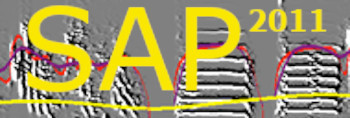Glossary of terms
| < PREVIOUS: Introduction to spectral analysis | > NEXT: Spectral derivatives |
|
|
|
|
|
|
|
Glossary of terms Sound Data: Sound data are defined as files of digital sound. See chapter 8 for information about digital recording, digitizing and re-sampling sounds.
Digital recording: is a sequence of sound pressure data (waveform) in a digital format. The two parameters that determine the quality of the data are sampling rate and sampling accuracy.
Sampling rate: determines how many samples of sound data are collected during one second (Hz), e.g. 44100Hz is sometimes referred to as ‘CD quality’. The accuracy of the digital representation of each sound pressure data is measured in bits, e.g. 16 bits means that each sample of sound is represented by one of 216 = 65536 possible values. Sound Analysis require accuracy of 16 bits and sampling rate of either 22050, 44100 or 88200 Hz.
Hertz: (symbol: Hz) is the SI unit of frequency defined as the number of cycles per second of a periodic phenomenon
Sound units: Sound Analysis distinguishes between silence intervals and signal.
Syllable: is defined as a continuous sound, bounded by silence intervals. Depending on the task, Sound Analysis sometimes treats the sound as a continuous analog signal and sometimes as a set of syllables.
Fourier transformation: Fourier transformation (FT) transforms a short segment of sound to the frequency domain. The FT is implemented algorithmically using the Fast Fourier Transformation technique (FFT).
Time window (frame): Time window is the duration of the segment of sound upon which Fast Fourier Transformation technique (FFT) is performed. Sound Analysis default is 409 samples of sound (9.3ms) and the next window starts 1.4 ms after the beginning of the previous one and has therefore an 85% overlap with the previous window.
Spectrogram: is a sequence of spectra computed on such windows, typically represented as an image where power is represented on a scale of gray ranging from white to black. Because frequency resolution is finite, the spectrogram does not capture a ‘pure sine wave’ but represents the ‘frequency’ as a ‘trace’ of a certain distribution in time and frequency. Using long time windows improves the frequency resolution at the expense of time resolution.
MultiTaper (MT) spectral Analysis: MultiTaper methods are a modern framework for performing spectral analysis. In particular, they lead to spectral estimates that are similar but superior to the traditional spectrogram. Apart from the estimation of the spectrogram, MultiTaper methods also provide robust estimates of derivatives of the spectrogram as well as provide a framework for performing harmonic analysis (detection of sine waves in a broadband noisy background).
Spectral derivatives: The traditional sonogram represents the power of sound in a time-frequency plan, while the spectral derivatives represent the change of power. The derivatives behave as ‘edge detectors’ of frequency traces in the time-frequency plan, and provide a superior spectral image.
Spectral Analysis:
|
|
